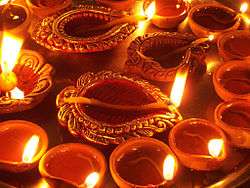Diya (lamp)
A diya, diyo, deya,[1] divaa, deepa, deepam, or deepak is an oil lamp usually made from clay, with a cotton wick dipped in ghee or vegetable oils. Diyas are native to the Indian subcontinent often used in Hindu, Sikh, Jain and Zoroastrian religious festivals such as Diwali[2] or the Kushti ceremony.

Traditional use
Clay Diyas are often used temporarily as lighting for special occasions, while diyas made of brass are permanent fixtures in homes and temples. Especially in Diwali, diyas or candles are representing of enlightenment, knowledge or wisdom.
Festivals
- Diwali: The lighting of diyas forms a part of celebrations and rituals of the festival. Houses are decorated with small diyas placed at boundaries and entrances.[3] In fact, the name of Diwali is derived from the Sanskrit word Deepavali, which means the row of lights ("deep" means Diya and "avali" means row).[4]
- Karthikai Deepam: Diyas, also known as deepam in Tamil Nadu, can be lighted, especially during the Karthikai Deepam.
Worship and prayers
A diya placed in temples and used to bless worshippers is referred to as an aarti.
A similar lamp called a butter lamp is used in Tibetan Buddhist offerings as well.
Types
In terms of the choice of material, the kiln fired earthenware lamps followed by the metallic lamps with multiple wicks, mostly of brass known as Samai, are the most common, though other materials are also used such as patravali floating lamp made from leaves or permanent lamps made of stones.
In terms of wick design, lamps with one wick are most common followed by the four wick styles, other variations such as two, five or sevel wick, etc also made.
In terms of overall lamps design, the ornamental lamps come in various designs. The iconic Nachiarkoil lamp, also known as "Annam lamp", is produced exclusively in by the Pather (Kammalar) community in Nachiyar Koil of Tamil Nadu.[8]
See also
- Other lamps
- Related topics
References
| Wikimedia Commons has media related to Diyas (lights). |
- Sacred Places of a Lifetime. Washington DC: National Geographic Society. 2008. p. 270. ISBN 978-1-4262-0336-7.
- "Diwali: Significance of a Diya". Zee Media Corporation Ltd. Retrieved 19 July 2013.
- The Asiatic Journal and Monthly Register for British and Foreign India, China, and Australia Front Cover Parbury, Allen, and Company, 1834, page 346
- Tej K. Bhatia and Naresh Sharma "The Routledge Intermediate Hindi Reader", Routledge, 2015 ISBN 1317962850, 9781317962854
- "Rituals after death as per Hinduism". Hindu Janajagruti Samiti. Retrieved 25 April 2018.
- "Introduction to death & dying". srimatham.com. Retrieved 25 April 2018.
- "Hindu Death Rites". Asian Cremation USA. Retrieved 25 April 2018.
- PM Narendra Modi gifts Xi Jinping Annam lamp, Times of India, 11 october 2019.